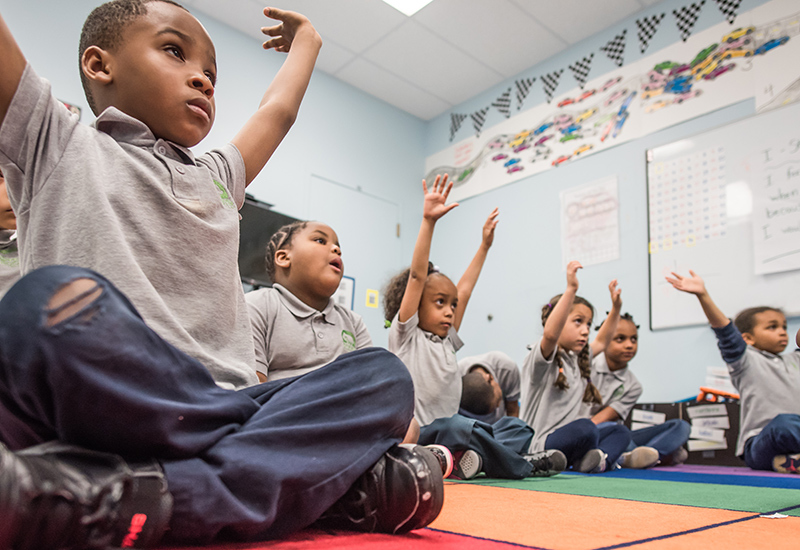Key Takeaways
- As with any resourcing question, there is a critical equity consideration at the center of this tension. Regardless of how the district/CMO makes staffing or resourcing decisions, the more student, teacher, and community member voice is part of the decision-making process, the more attuned system leaders will be to what resources are actually needed and where.
- “Readiness” is about teachers and school leaders having both the willingness to engage with new practices and also having the skills/knowledge to do so.
- Regardless of how allocation decisions are made, communicating these decisions clearly, transparently, and consistently offers the most agency to schools and enables them to make empowered choices.

Context
No system’s context is exactly the same as another’s, and therefore pathways to system change cannot completely replicate each other. While case studies on system-wide implementation offer inspiration and ideas, they can be difficult to apply in new contexts.
Regardless of context, however, all leaders interested in scaling new approaches face choices about how to lead system change in a way that maximizes benefits to students. In interviews across the country, we found that certain decisions kept surfacing as critical to success, many of which contained competing priorities - forces pulling in different directions. Rather than choose one priority and ignore the other, leaders explain, the key is to figure out how to manage both in a way that best fits your context.
Overview of the Challenge
Most districts/CMOs have limited resources, both financial and in terms of human capital, which leads to well-documented capacity shortages. Leaders must continually make choices about how to distribute scarce resources, including their own time and energy. What criteria should leaders use when making these allocation choices? Focusing first on schools or communities with the most need honors a moral imperative to students, but if those communities have other priorities, the resources could go unused. Allocating based on interest and readiness may increase engagement and effectiveness, but also may funnel resources into areas where they are less needed.
Why Prioritize Need?
“Need” can mean a variety of things. It may describe schools that have historically been the most underfunded or under-resourced. It may also refer to schools with the highest achievement gaps, either between groups of students in the same school or between the school and the rest of the district. Need may also arise due to a particular social moment or dynamic (such as a recent political or environmental event, or a sudden change in population). Regardless of how it is defined, allocating resources to the schools and students that need them most fulfills a fundamental promise of the education system: providing equal opportunities and access to all students.
While need and readiness are not mutually exclusive, here are examples that highlight a focus on addressing school or community need:
Why Prioritize Readiness?
Many leaders expressed the importance of piloting new instructional practices with school leaders and/or with teachers who were either already engaging in blended learning on their own or were willing and able to dedicate significant time and energy to shifting their practice. Schools that make an effort to demonstrate readiness have already shown their commitment to continue. This allows system leaders to play the role of “cheerleader,” supporting school efforts as opposed to spending time trying to convince school leaders or teachers of the value of change. It also taps into a network of practitioners who may be engaging in highly effective instructional practice and provides them with future leadership opportunities.
While need and readiness are not mutually exclusive, here are examples that highlight a focus on school or teacher readiness:
The following strategies provide a good example of blending both approaches:
What the Data Say
In a survey of 89 leaders from 60 systems across the country:
- 54% of respondents reported a focus on readiness, while only 26% claimed to focus more on need
- Large and urban districts are more likely to prioritize need, while those serving small populations of students who qualify for free-and-reduced lunch are more likely to focus on readiness
- 86% of respondents reported that they had dedicated time and resources to managing this tension.
- Navigating the trade-off between school need and readiness was cited as a top-priority challenge by 52% of participants. Systems serving larger percentages of free free-and-reduced lunch students (>50-99%) were over twice as likely to cite this as a relevant issue.
Want a deeper dive into the data? Explore our white paper, entitled Look Both Ways for more information.
Take It Further
To jump start your own discussions, consider these questions:
- Who and what determines “need” or “readiness”?
- How much of the resource allocation decision should be top-down (i.e. district/CMO leaders choose what to fund, when, and how) and how much should be bottom-up (i.e. schools put a plan together to request support in a way that best serves their needs)?
- To what extent does flexibility (of central office support, funding, and other resources) help or hinder change efforts?